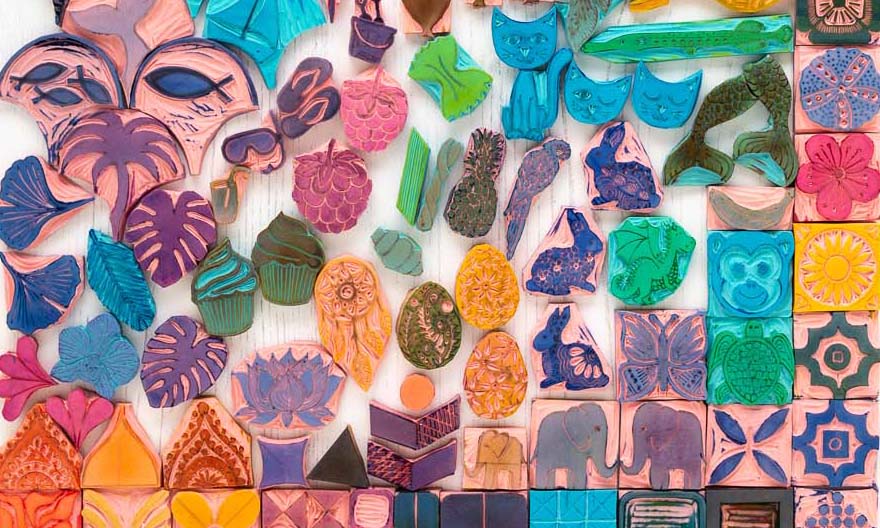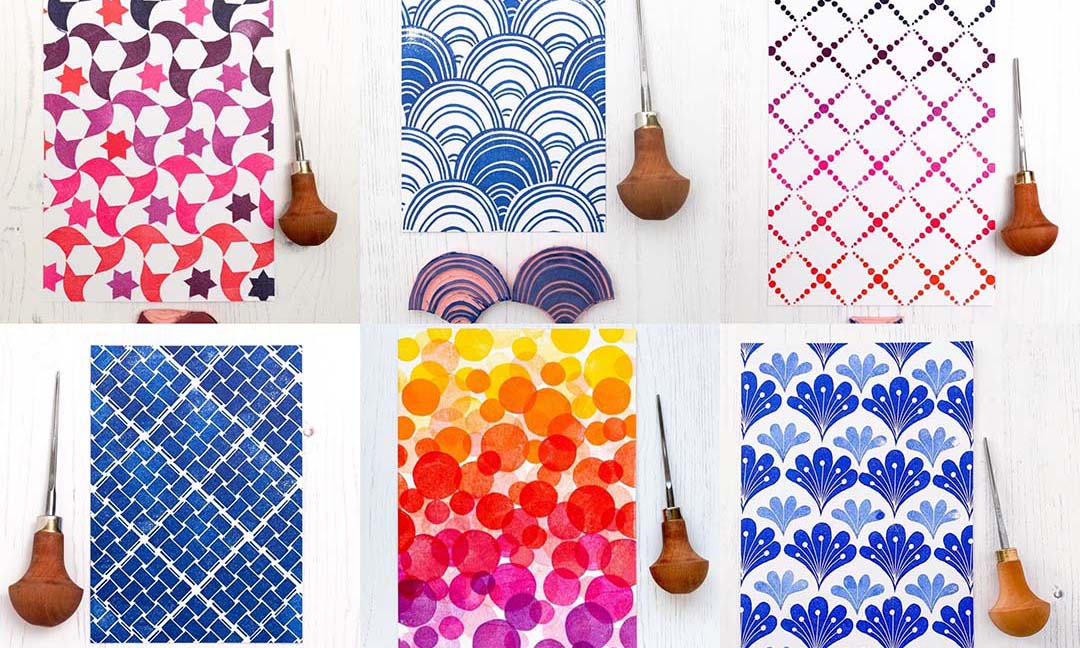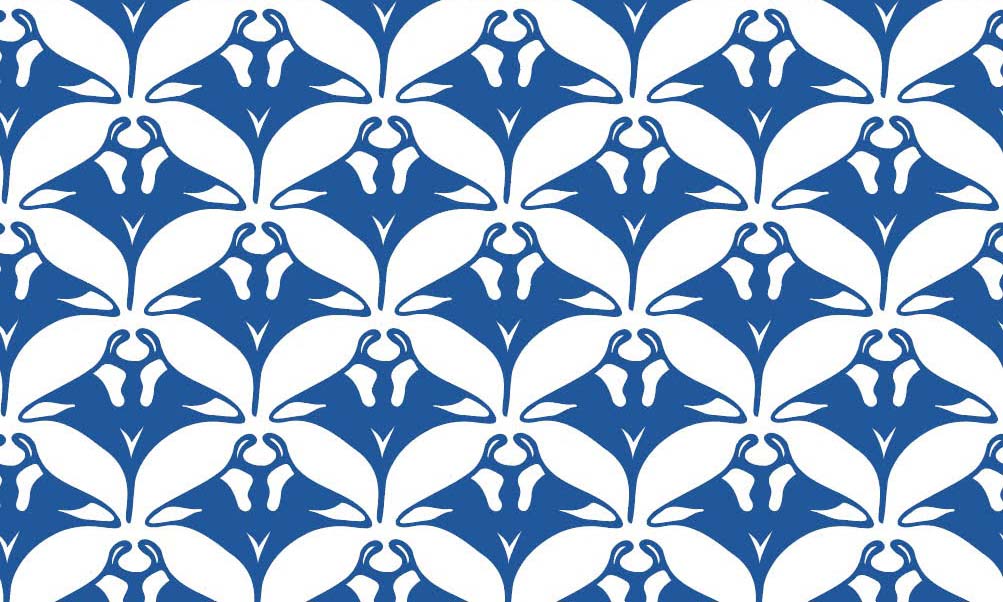08 Feb What is a creative challenge and how can it help you reaching your (creative) goals.
You might have heard me talk about how creative challenges have been a massive part of my creative process and have significantly impacted my creative growth and learning process as 3 Dotted Penguins. I genuinely believe that I would not be where I am today as a block printer and surface pattern designer without joining creative challenges early on in my creative life.
In this post, you will find more information on
- What a creative challenge is (think 30-day challenges, 100-day, 52-weeks or 365-day projects),
- How to set yourself up for a month-long or longer creative challenge and
- How a creative challenge can help you in reaching your creative goals – no matter if you are a hobbyist, if your creativity is your (side) business (or want to make it one) or extend your creative practice or learn something new as a full-time creative business owner
So, what is a (creative) challenge?
A creative challenge is a project with the sole focus on doing/creating/making something specific (whatever you choose) for a given period. This could be daily for a month (as in “30-day challenge“), for 100 days (100-day project), once a week for a year (52-week challenge) or every day for a whole year (365-day project) to name a few challenge types.
Over the years, I have started and completed a 365-day photography project to further my photography skills, finished a 100-day block printed patterns project, took part in various 30-day block printing challenges. I started a 52-week project twice and never finished one – I realised I work much better if I do something regularly, aka daily. In the first year after starting the Instagram account of 3 Dotted Penguins (that I opened for a 52 week challenge), I completed three individual 30-day-challenges and one 100 day project instead. All in one year. Phew. Next to a baby and a day job.
Please know that many examples in this post will mention 100-day projects, but you can apply the same principles to (creative) challenges of any length.
Picking a topic
The topic of your 100-day project describes what your challenge will be about.
Ask yourself what you would like to dedicate your 100 days to. For example, you could pick 100 days of sketches, 100 days of block prints, 100 days of being mindful, 100 days of taking a photo (be specific what motives) every day, 100 days of giving back to the community, 100 days of learning a new skill or computer program. You might even pick something that will help you set up a grow your business. Choosing and being clear about a topic will keep you focused.
Some things to consider:
- Is there something new you would like to learn or immerse yourself further in?
- Be clear about how much time you will – realistically – have to dedicate to the project. Is it 15 minutes? Is it an hour every day? This will impact the topic and boundaries you need to choose. Want to make a new stamp and block print in 15 minutes? You might want to go for very simple shapes or super small blocks and only small pieces of paper.
- Be specific about your topic – actually, the more specific, the better. Of course, you can do 100 days of creativity. Still, you might find it easier to follow through with a more specific topic, such as 100 days of block prints or 100 days of patterns (be clear how you want to achieve them, perhaps you already know that you will block print them on fabric, or make them in Adobe Illustrator or Procreate). You can get even more specific in 100 days of stitched watercolors or 100 ginkgo leaves – both actual and completed projects by other artists.
- If you feel your topic is too big for your project, try to break it down. Doing something for, e.g. 100 days, does not mean that you will need to create 100 finished pieces in 100 days. So instead of saying you will do 100 block prints or carve 100 stamps, you could plan to do 100 days of block printing – this means you can work on block printing for 100 days but will not necessarily produce 100 individual block prints. You could brainstorm on the first day, sketch the next, carve on the third day and print on the fourth day. And then repeat until you reach 100 days.
Following an "official" challenge
You can find plenty of “organized” challenges, e.g. on Instagram, such as the 30 days #inktober and #printinktober challenges in October, #carvedecember in December or #the100dayproject, which in 2022 starts on February 13. This means a person or team of creatives behind the specific challenge will provide some structure and guidance for the respective challenge. In some cases, these challenges already will come with specific themes (e.g. only for block printing or stamp carvers or everyone who draws); others will be completely free in what you choose to do (such as some 100-day and 365-day projects) but creates an opportunity for people to connect and perhaps even provides a small support structure.
One advantage of following an official challenge is that you are not going through your project on your own; there is a community of people going through the challenge simultaneously. You will see what other people create and be surrounded by like-minded people. The chances are high that you will be cheering each other on in no time. Over the years, I have found countless inspiring creatives with diverse creative practices through challenges – many of their work I still follow after 2 + years.
Please also know that you can generally join a challenge (with a set start date, such as the 100-day project starting on February 13) at a later point. In my first year of #the100dayproject, I joined a week or two after it started.
The rules
To make it clear right from the start: you set your own rules for your creative challenge, no matter if you ultimately make your own creative challenge or follow an official (creative led) challenge which might come with a set of rules – but you can still decide the details and if you have any areas where you want to deviate from the rules. Disclaimer: There might be some challenges (especially if there are prices or similar involved) where rules must be adhered to more thoroughly.
Setting the rules can be fun and challenging at the same time. It might feel easier at the start to keep everything open, but you will see the clearer (and more realistic) you are about your rules, the more satisfying the project will be for you. They are there to provide you with clarity and boundaries. Be specific. Note down your rules.
Your rules can includ for example:
- What topic are you covering, and what is the name of your project
- Which mediums do you want to work with (if it is a creative project) or other specific details about your project
- How much time will you spend every day?
- What is your cadence? Daily?
- What happens if you miss a day – do you skip it, or will you try to catch up or extend your project by the respective number of days?
Keep your rules as simple as possible. That way, you will be able to follow them easily.
Also, remember that your rules are not set in stone. They can be broken (if needed). So don’t give up on your rules if you have one or two days but if you see repetitively that something is not working for you, change it.
Prompts or no prompts
Many official challenges will provide prompts, i.e. lists of (daily) words or (monthly) themes to follow during a challenge. They can be a great idea generator because they might cover themes you usually might not be drawn to and therefore help you think outside your creative box. Especially with bigger, more broad challenges such as the #100dayproject or #inktober, you will find several prompt lists, often by other participating artists.
If you are not following one of the official challenges, you can always set your own prompts. If following prompts is not your thing, just go with the flow.
To show or not to show your work
How (creative) challenges can help you reach your (creative) goals
No matter what your (creative) goal looks like, creative challenges can help you get there. This includes refining your skills, finding your style or working towards that one next big goal (producing artwork/products for an online shop, getting started writing a book, getting consistent on social media by making it a habit to post regularly, you name it).
Be creative in how you define your 100-day project or your creative challenge. You will soon notice that you will find the time even on the busiest day by making your creative project a priority.
Creative challenges are a great way to
- Form a daily (creative) habit. You will most probably profit from it after the end of the challenge. Habits need time to develop, and creativity is a muscle that gets better with training.
- Help define or refine your style by finding what works for you creatively and what you currently enjoy. In my first year of 3 Dotted Penguins, creative challenges helped me explore and hone in on what I enjoyed most.
- Consistently refine your skills (you can make a massive amount of progress by just working on your skills daily (even shortly) for a given period – not only if you are learning an entirely new skill).
- Make consistent progress towards a goal.
- Beat procrastination by consciously setting aside time (perhaps even timed slot) every day for your project, for your creativity.
- Show your work to the world
- Connect with like-minded people
- Most importantly, have fun
How to track your 100 day project
Changes are high that you will loose track of the exact day your on for your 100-day project. I for sure do (I used to go back to previous Instagram posts to see which day I posted last or counting unposted project work).
I made this handy printable pdf to help keep track of the progress of the 100-day project. I hope you find it as helpful as I do.
Have you ever done a creative challenge, aka a 30-, 100- day or even longer project? What was it about? Let us know in the comments below.
Posts about my previous 100-day projects that you might like
My 1st (finished) 100-day project – 2019





Beatrix W
Posted at 12:17h, 09 FebruaryI’ve just enjoyed reading your blogpost about creative challenges. I have been following you and a couple of other block print artists on Instagram since I did a block print course two years ago in Sydney, and have done one of your great online courses.
Your post has inspired me to have a go at a creative challenge and to “make the time” as I always feel too time poor, but like you I love some creative time and space and would love to make it a daily habit.
Am locking in 20 mins a day.
Thanks for the inspiration!
Ali
Posted at 13:07h, 09 FebruaryAww, that makes me so happy. A big “yay” to 20 minutes of creativity a day! Beatriz, congrats on having a go at a creative challenge. Cheering you on from afar!
Happy creating, Ali
Eleanor Segal
Posted at 18:06h, 11 FebruaryThat you for your thorough post on challenges and practices!. I have been making art for a long time, but it seems since carvedecember really got me going working in my studio daily, mostly carving and printing. Now I feel the pull to go back to some of my other art practices… drawing, botanical contact print, embroidery, multimedia, mark making. I have mixed feelings about social media… it can be a double edged sword: inspiration/distraction. I love seeing others work and mine, giving and getting feedback. I am feeling the need to take a break form social media and classes and work quietly in my studio, exploring my multiple areas of interest. Thanks again for your clear articulation and wonderful classes.
Ali
Posted at 23:27h, 11 FebruaryGlad you enjoyed the post, Elli. I absolutely agree on social media being a double-edged sword. In the end everyone needs to decide for themselves if/how often/how long they want to use it.